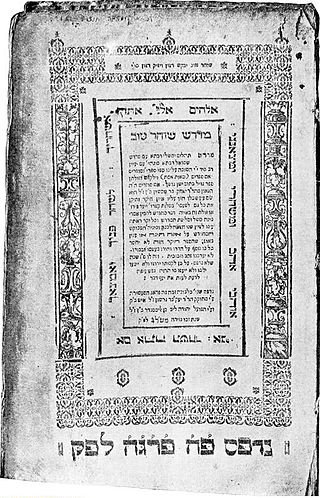Related Research Articles

The Tosafot, Tosafos or Tosfot are medieval commentaries on the Talmud. They take the form of critical and explanatory glosses, printed, in almost all Talmud editions, on the outer margin and opposite Rashi's notes.
Eleazar of Worms, or Eleazar ben Judah ben Kalonymus, also sometimes known today as Eleazar Rokeach from the title of his Book of the Perfumer —where the numerical value of "Perfumer" is equal to Eleazar, was a leading Talmudist and Kabbalist, and the last major member of the Hasidei Ashkenaz, a group of German Jewish pietists.
Judah ben Samuel of Regensburg, also called Yehuda HeHasid or 'Judah the Pious' in Hebrew, was a leader of the Chassidei Ashkenaz, a movement of Jewish mysticism in Germany considered different from the 18th-century Hasidic movement founded by the Baal Shem Tov.
Isaac ben Moses of Vienna, also called Isaac Or Zarua or the Riaz, is considered to be one of the prominent rabbis of the Middle Ages. He was probably born in Bohemia and lived between 1200 and 1270. He attained his fame in Vienna and his major work, the halachic guide known as the Or Zarua a compilation of halachic decisions and legal rulings, was very popular among Ashkenazic Jewry. He was a member of the Ashkenazi Hasidim and studied under many scholars, including Eliezer ben Joel HaLevi, Judah ben Samuel of Regensburg, Samson of Coucy and Eleazar of Worms. He was among the teachers of Meir of Rothenburg.
Moshe haDarshan was chief of the yeshiva of Narbonne, and perhaps the founder of Jewish exegetical studies in France. Along with Rashi, his writings are often cited as the first extant writings in Zarphatic, the Judæo-French language.
Rabbi Isaac ben Jacob or Yitzhak ben Yaakov, nicknamed "ha-Lavan" or "the white" was a 12th-century rabbi of Bohemia. He was a Tosafist and liturgical poet who flourished at Prague in the late 12th century.
Tobiah ben Eliezer was a Talmudist and poet of the 11th century, author of Lekach Tov or Pesikta Zutarta, a midrashic commentary on the Pentateuch and the Five Megillot.
Isaac ben Samuel the Elder, also known as the Ri ha-Zaken, was a French tosafist and Biblical commentator. He flourished at Ramerupt and Dampierre, France in the twelfth century. He is the father of Elhanan ben Isaac of Dampierre.
Judah ben Isaac Messer Leon (1166–1224) was a French tosafist born in Paris.
Abraham ben Isaac of Narbonne (c. 1080-85 – 1158) was a Provençal rabbi, also known as Raavad II, and author of the halachic work Ha-Eshkol.
Baruch ben Isaac, called usually from Worms or from France was a French halakhist and Talmudist. He is not to be identified with another Baruch ben Isaac, a Tosafist and codifier who was born at Worms, but lived at Regensburg,.

Midrash Tehillim, also known as Midrash Psalms or Midrash Shocher Tov, is an aggadic midrash to the Psalms.

The Yalkut Shimoni, or simply Yalkut, is an aggadic compilation on the books of the Hebrew Bible. It is a compilation of older interpretations and explanations of Biblical passages, arranged according to the sequence of those portions of the Bible to which they referred.
Joseph ben Baruch was a French rabbi, a tosafist of the twelfth and thirteenth centuries. Gross identifies him with Joseph of Clisson. Joseph resided for some time in Paris, where he associated with Judah Sir Leon and instructed Samuel of Falaise in special subjects.
Aaron ben Gershon Abu Al-Rabi of Catania was a Sicilian-Jewish scholar, cabalist, and astrologer of the 15th century.
Moses of Évreux was a French tosafist, one of three brothers, and author of a siddur, who flourished at Évreux in Normandy in the first half of the thirteenth century. His father was Shneur of Évreux who left behind three children each of them outstanding scholars: Moses of Évreux, Samuel of Évreux and Isaac of Évreux. Moses was the oldest brother and teacher of his younger brothers. They were collectively called "the sages of Évreux".
Eliezer of Touques was a French tosafist, who lived at Touques in the second half of the thirteenth century. He abridged the tosafot of Samson of Sens, Samuel of Évreux, and many others, and added thereto marginal notes of his own, entitled "Gilyon Tosafot," or "Tosafot Gillayon". This abridgment, together with the notes, after undergoing many alterations and receiving several additions from later authorities, was called Tosafot Ṭuk; it forms the foundation of the Tosafot now printed with the Talmud.
Isaac ben Abraham, also called Rabbi Isaac ha-Baḥur and by its Hebrew acronym RIBA (ריב"א) or RIẒBA (ריצב"א), was a tosafist of the late twelfth and early thirteenth centuries.
Isaac ben Judah HaLevi was a French exegete and tosafist; lived at Sens, probably, in the second half of the thirteenth century.
References
![]() This article incorporates text from a publication now in the public domain : Singer, Isidore; et al., eds. (1901–1906). "Hayyim of Falaise (Hayyim Paltiel ?)". The Jewish Encyclopedia . New York: Funk & Wagnalls.
This article incorporates text from a publication now in the public domain : Singer, Isidore; et al., eds. (1901–1906). "Hayyim of Falaise (Hayyim Paltiel ?)". The Jewish Encyclopedia . New York: Funk & Wagnalls.